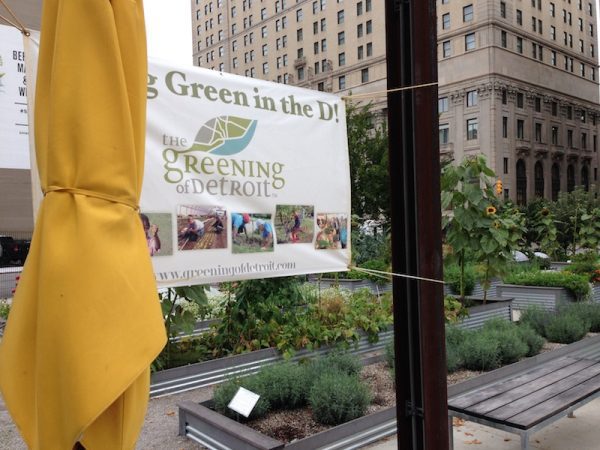Lessons for Charlotte in Detroit?

“Downtown was the center of the universe. And then it all changed.”
Matt Cullen, CEO of Rock Ventures, a major real estate player in downtown Detroit, was speaking to out-of-town visitors and describing changes in the once thriving, now seriously ailing Motor City.
I was in town for a conference (Meeting of the Minds 2014) focusing on innovations in cities and the role of bottom-up creativity. And, confession time, I also hoped to satisfy a prurient curiosity: How bad are things in Detroit? Is the rebirth I’ve been hearing and reading about just hype, or real?
Cullen’s remark stuck with me. He spoke at a reception in his company’s One Woodward building, near the heart of downtown Detroit. Later, dodging construction for the city’s planned 3.3-mile streetcar, I walked several blocks up Woodward Avenue, one of the city’s spines that is reportedly reviving with tech start-ups and creative entrepreneurial activity. I did see signs of that, a coffee shop here, a restored building there. I also saw plenty of empty storefronts and empty buildings in varying states of decay or repair.

Analyzing the complex stew of factors that poisoned Detroit would take more space than I have here. Ingredients include the obvious – the demise of the U.S. auto industry, inept and/or corrupt city government, white flight, racial animosity and a crippling national housing meltdown – and some not-so-obvious factors, among them a lack of healthy regional cooperation and, not least, a cold climate and the lure of warmer places.
One of those warmer places is Charlotte, a sort of reverse-Detroit if you consider 21st-century economic vigor. As I headed back to the Detroit airport my cab driver, hearing I was from Charlotte, said his friend just moved to Charlotte. I said I hoped the friend had a job because unemployment in Charlotte had been pretty bad and was still not great. “Doesn’t matter,” he said. “There’s no snow.”
Hearing Cullen describe how Detroit’s misfortune arrived in a place that had been so full of itself made me wonder whether Charlotte or any other city can fully prepare for unexpected and precipitous decline. And if that decline hits, how prepared would it be to reinvent itself?
Detroit is an extreme example, but plenty of cities in the formerly industrial Rust Belt have faced decades of fading growth and municipal travails. They’re dubbed “legacy cities,” and urban experts are examining how or whether they can turn around. Regenerating America’s Legacy Cities by Alan Mallach and Lavea Brachman is one such study, published in 2013 by the Lincoln Institute of Land Policy.
If you were in Charlotte in October 2008, you know how terrifying those weeks felt, as if the city’s high-flying financial industry were spiraling downward and possibly carrying the city’s economy into Detroit-like depths. Charlotte bounced back – mostly – but that sense of vulnerability hasn’t vanished. With all that in mind, I read the legacy cities report on the trip home, looking for wisdom that might apply even to a growing and reasonably healthy metro region such as Charlotte (or Jacksonville, Orlando or Houston, for that matter).
Some sections seemed to warn against the complacency typically found in a young, growing place like the Queen City:
- “Growing areas may appear to be inexpensive early in their life cycles, but incur additional costs for infrastructure repairs and maintenance as they mature, becoming more expensive over time.”
- “Correcting these problems [of rising local government costs amid decreasing revenues] requires structural changes. … For instance, regional [emphasis mine] chambers of commerce should address and encourage incentives among jurisdictions to prevent poaching of businesses from one jurisdiction to another.”
- “While many of these [legacy] cities are currently in fiscal crisis, they have subsidized their regions for years both directly and indirectly. … It is essential to address equity issues in order to promote sustainable business and economic growth … Regions cannot rely solely on recruiting talent from outside the area.”
- “Enabling urban residents to access suburban jobs, which demands a regional employment strategy, is likely to have as much effect on resident well-being as will job growth inside the city.”
- Major sports, gambling and entertainment facilities can catalyze economic regeneration “only to the extent that they are integrated into a larger strategy, which leverages their potential impacts … even then, their impacts may be less than if the same amount of money were used for alternative economic development strategies.”
- “Successful regeneration … rarely results from a single megaproject, but more often comes from the cumulative effect of smaller initiatives.”
Charlotte is not Detroit, in many ways besides warmer winters. An incomplete list might include Charlotte’s history of low-paying textile jobs as opposed to high-paying auto-making ones, its much larger land area (298 square miles, compared to Detroit’s 139), and not being perched on a big river, much less having another country on the far shore. And Charlotte will have to undergo a massive culture shift before it accepts a giant downtown memorial to the U.S. labor movement.
But one big lesson from Detroit is that every city is potentially vulnerable.
And every city probably holds the seeds of its own regeneration, if it can find – as Detroit has – local leadership that just will not let it die.
The Michigan-based Kresge Foundation has played a monumental role. So has billionaire businessman Dan Gilbert. The founder and chairman of Quicken Loans and Rock Ventures, a casino and sports team owner (he’s part-owner of the Cleveland Cavaliers), has been buying and restoring historic downtown buildings for four years. He now owns some 60 buildings in the area, according to Crain’s Detroit Business.
It does not hurt to have a billionaire and a major national foundation in your corner. Rip Rapson, CEO of Kresge, described some of what the philanthropic community has done, including raising almost $175 million privately to plan and create the Woodward Avenue light rail system. “It was a crazy idea,” he said. “Foundations don’t build light rail.”
Kresge also spearheaded a Detroit Future City plan, involving 50,000 residents, and has provided high-risk early stage capital when the private sector wouldn’t. “The transformation of the city has been extraordinary,” he said.
With all that energy and enthusiasm, I came away still unsure whether Detroit will ultimately grow strong again or sink into Third World city status. I saw funky urban gardens and burned-out rubble. I saw stable neighborhoods and desolate ones, and the crumbling hulks of some very big buildings. And the tour I took, of small urban interventions, did not even go to the worst areas.
So is Detroit’s revival is hype or real? The answer seemed to be “too soon to tell, but it just might work.”
Heading home, I chatted with the cab driver and said I’d been wondering if Detroit would revive or just die away.
“How can a city die?” he replied. “It’s a city.”
Mary Newsom is associate director of urban and regional affairs at the UNC Charlotte Urban Institute. Commentary articles reflect the opinions of the writer, not necessarily those of the institute or the University of North Carolina at Charlotte.